Bacterial Anatomy and Pathogenicity Pt 1
1/138
There's no tags or description
Looks like no tags are added yet.
Name | Mastery | Learn | Test | Matching | Spaced |
|---|
No study sessions yet.
139 Terms
what term refers to a disease being transmittable between persons or species? what term refers to an individual who is capable of transmitting a disease or a disease that is transmissible by direct or indirect contact?
communicable; contagious
what term refers to microbes that frequently associated with disease production?
pathogens
what term refers to the mechanism a microbe uses to cause the disease state?
pathogenesis
what term refers to the replication of a pathogen in or on its host?
infection
specific ________ and __________ are associated with a specific disease
signs, symptoms
what are 5 things that can determine the host's susceptibility and resistance to infection?
1. immune status
2. age
3. other conditions
4. epidemiology
5. environment
primary vs opportunistic pathogens: tend to produce disease readily in healthy hosts
primary
primary vs opportunistic pathogens: cause disease when displaced to an unusual site
opportunistic
primary vs opportunistic pathogens: cause disease when the host has a weakened immune system
opportunistic
what are 3 things that causes opportunism for pathogens?
1. host defense failure
2. microbe in unusual location
3. microflora disturbance
what are the 4 components of Koch's Postulates?
1. microorganism must be found in abundance in all organisms suffering from disease, but not found in health organisms
2. microorganism must be isolated from a diseased organism and grow in a pure culture
3. cultured microorganism should cause disease when introduced in healthy organism
4. microorganism can be reisolated from inoculated, diseased host and identified to be identical to the original specific causative agent
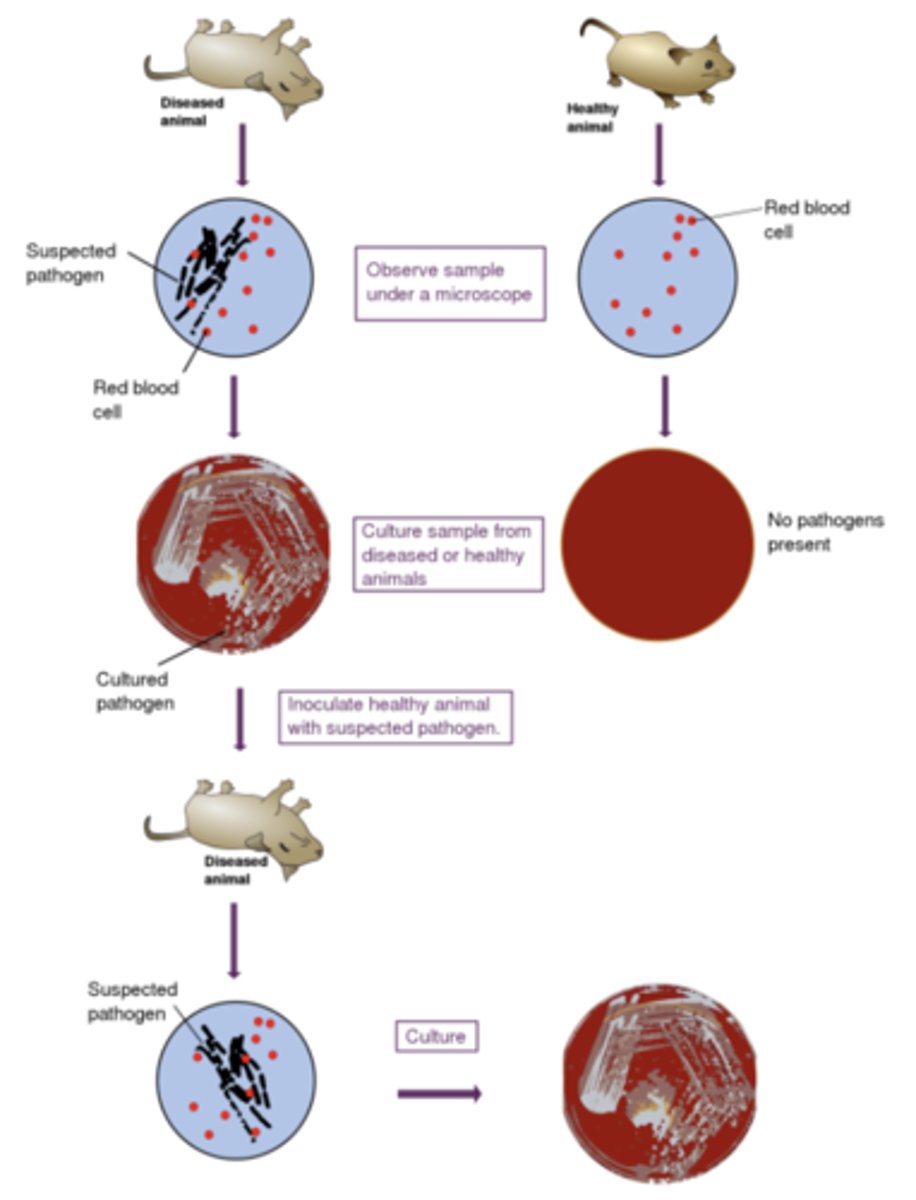
what are 3 things used to validate the purative virulence genes in the Molecular Koch's Postulate?
1. the phenotype of a disease symptom must be associated with a specific genotype only found in pathogenic strains
2. symptom should not be present when the associated gene is inactivated
3. symptom should return when the gene is reactivated
what are the 9 components of the Bradford Hill criteria?
1. strength (effect size)
2. consistency (reproducibility)
3. specificity
4. temporality
5. biological gradient (dose-response relationship)
6. plausibility
7. coherence
8. experiment
9. analogy
what does the strength criteria in Bradford Hill state?
a small association does not mean that there is not a causal effect, though the larger the association, the more likely that it is a causal effect
what does the consistency criteria in Bradford Hill state?
consistent findings observed by different persons in different places with different samples strengthens the likelihood of an effect
what does the specificity criteria in Bradford Hill state?
causation is likely if there is a very specific population at a specific site and disease with no other likely explanation; the more specific an association between a factor and an effect is, the bigger the probability of a causal relationship
what does the temporality criteria in Bradford Hill state?
the effect has to occur after the cause; if there is an expected delay between the cause and expected effect, then the effect must occur after that delay
what does the biological gradient criteria in Bradford Hill state?
greater exposure should generally lead to greater incidence of the effect; however, in other cases, an inverse proportion is observed where greater exposure leads to lower incidence
what does the plausibility criteria in Bradford Hill state?
plausible mechanism between cause and effect is helpful
what does the coherence criteria in Bradford Hill state?
coherence between epidemiological and laboratory findings increases the likelihood of an effect
what does the experiment criteria in Bradford Hill state?
occasionally it is possible to appeal to experimental evidence
what does the analogy criteria in Bradford Hill state?
the use of analogies or similarities between the observed association and any other associations
what term refers to the subjective sensation that the person feels from the disorder?
symptom
what term refers to the objective evidence of disease as noted by an observer?
sign
what term refers to a specific group of signs and symptoms that accompany a disease?
syndrome
what term refers to a condition that is the consequence of a previous disease or injury?
sequelae
what is an acute disease?
symptoms develop rapidly
what is a chronic disease?
an ongoing disease characterized by long suffering
what is a subacute disease?
intermediate between acute and chronic
what is a latent disease?
disease with a period of no symptoms when the causative agent is inactive
what is a local infection?
pathogens are limited to a small area of the body
what is a focal infection?
when infectious agent breaks loose from a local infection and is carried to other tissues; this is what supports the hypothesis that an infection can cause a chronic disease
what is a systemic disease?
disease that affects the body as a whole
what is bacteremia?
bacteria in the blood
what is septicemia?
blood poisoning
what is viremia?
viruses in the blood
what is sapremia?
blood poisoning caused by toxins from putrefactive bacteria (like gangrene)
what is a primary infection?
initial infection
what is a secondary infection?
a different and opportunistic infection after a primary infection
what is a superinfection?
a second infection superimposed on an earlier one, especially by a different microbial agent of exogenous or endogenous origin
what is a mixed infection?
several microbes grow simultaneously at the infection site
what is a subclinical infection?
no symptoms or mild enough to go unnoticed
the Gram staining method uses a complex between the dyes _________ ________ and ___________ which is retained in the cell (membrane/wall) of the stained bacteria
crystal violet, iodine, wall
what does coccus mean?
spherical
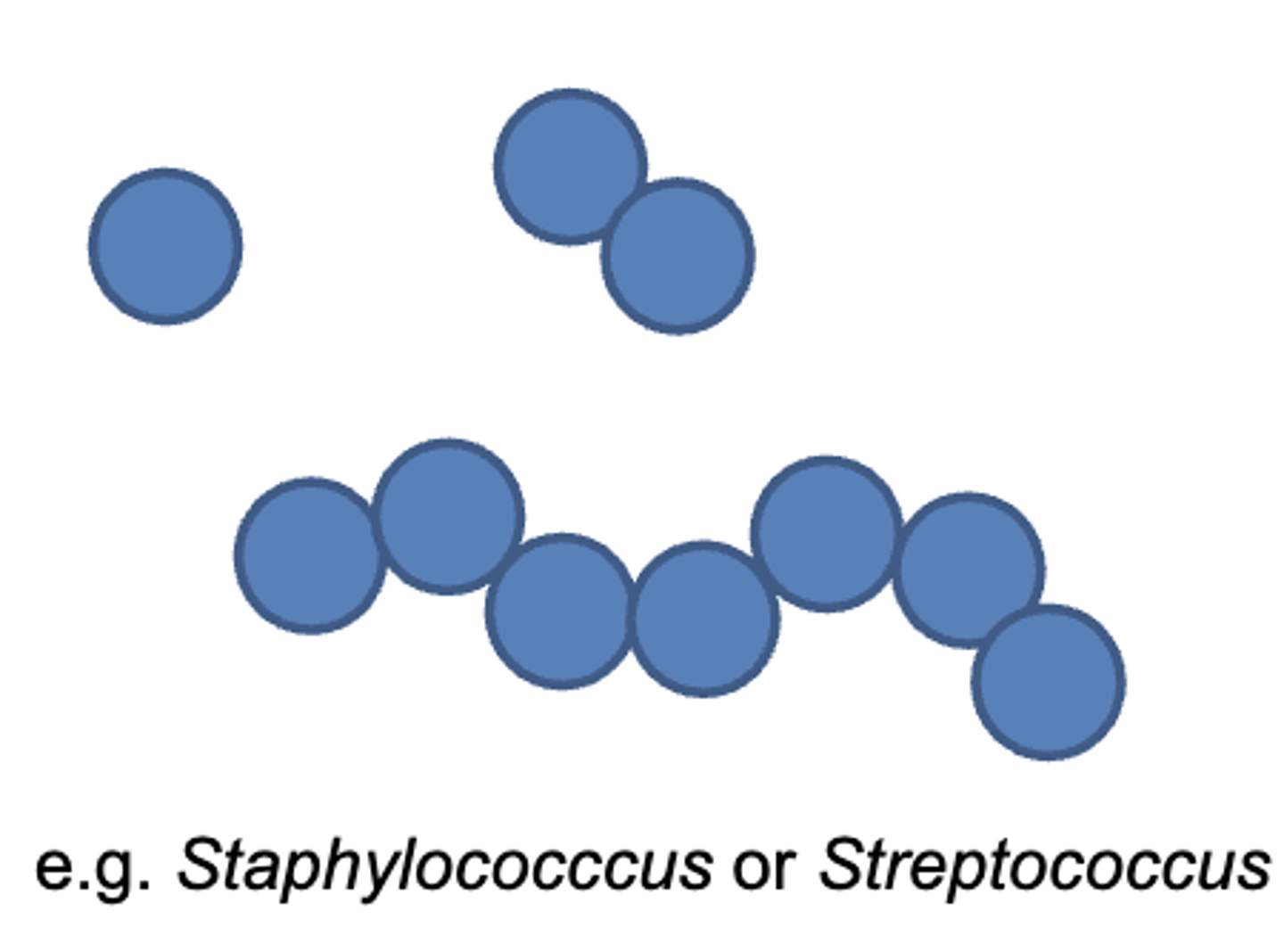
what does spirillum mean?
spiral
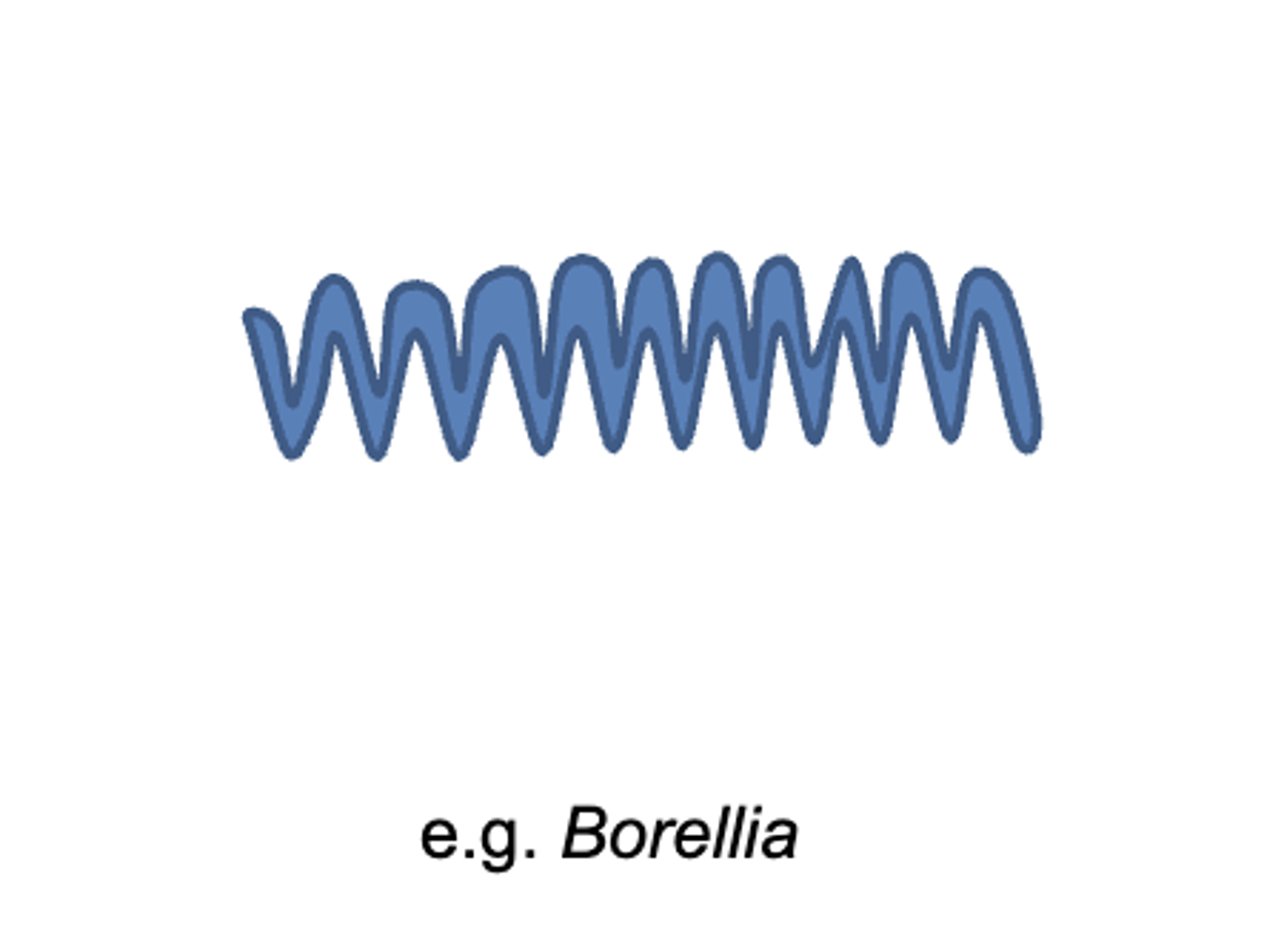
what does bacillus mean?
rod shaped
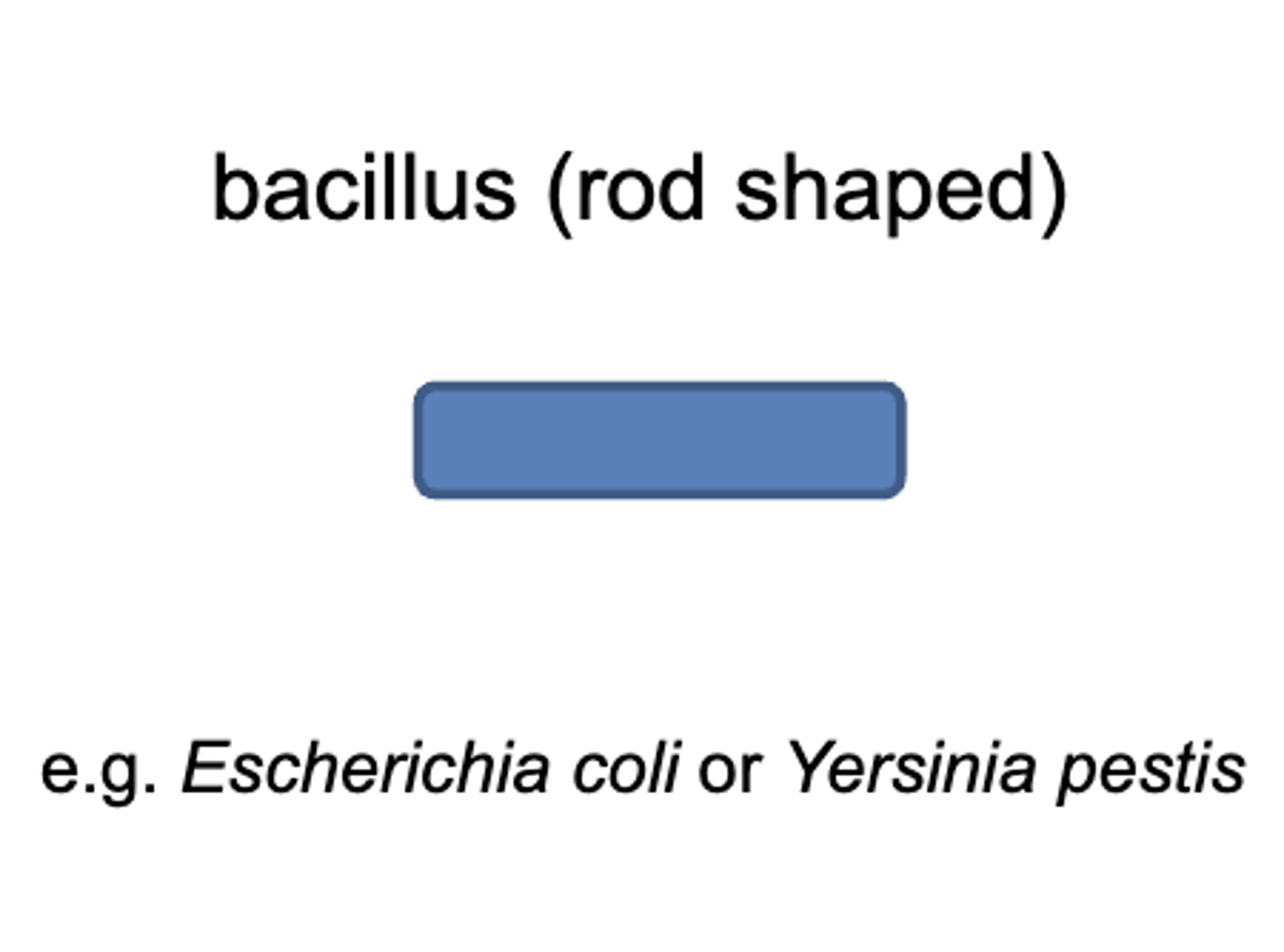
what does vibrio mean?
curved rod
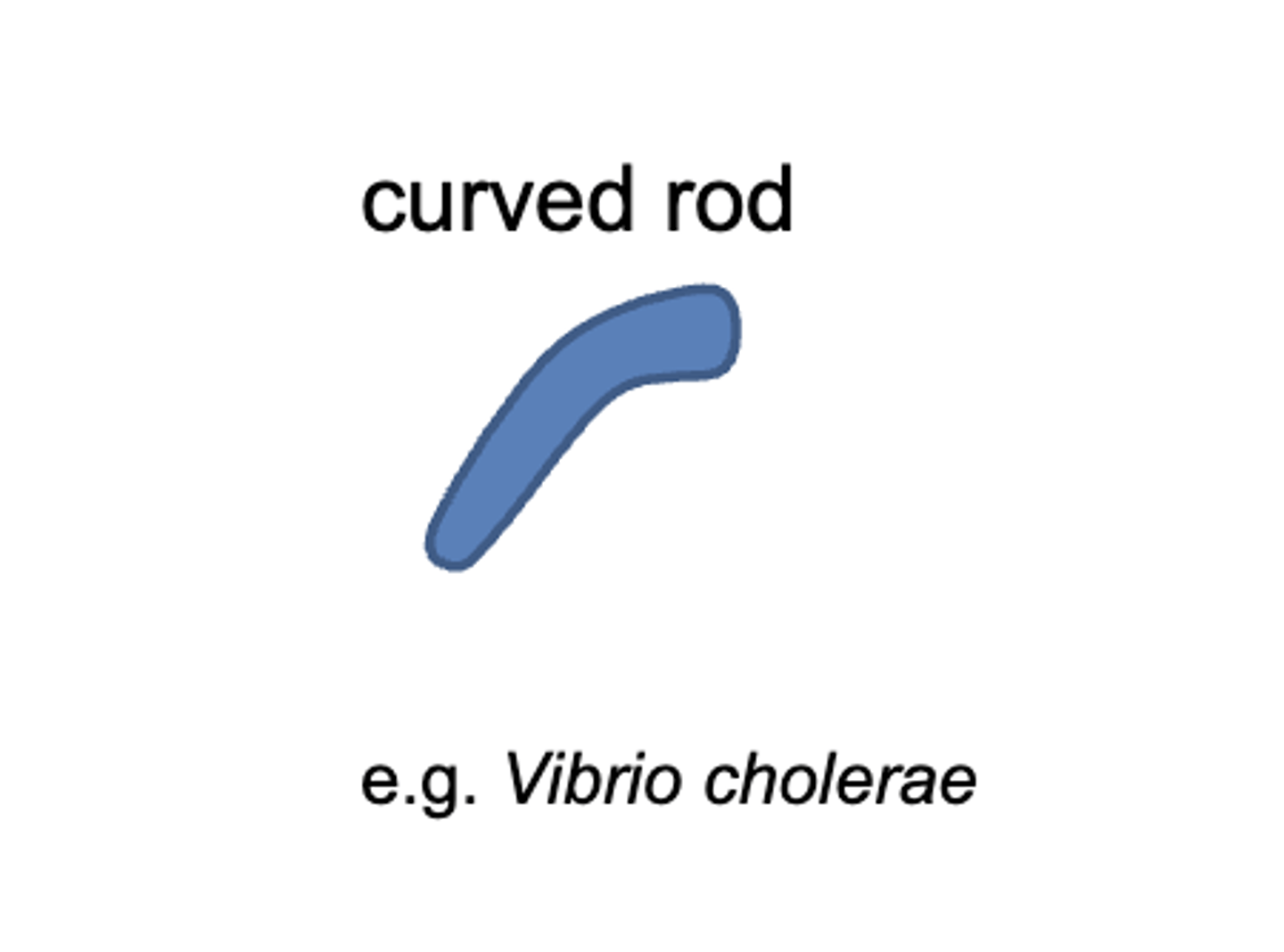
what does the prefix di- mean?
paired
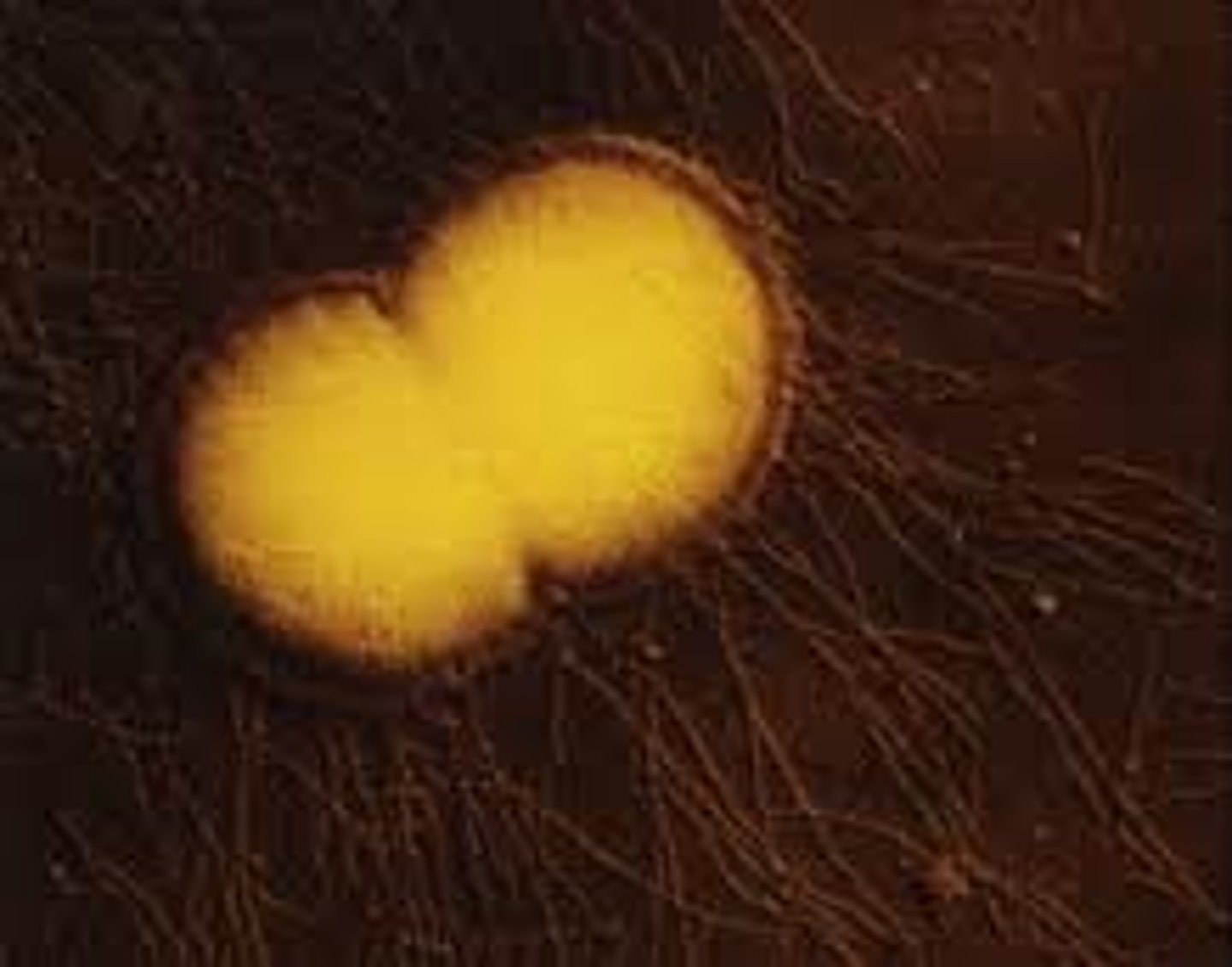
what does the prefix strepto- mean?
chains
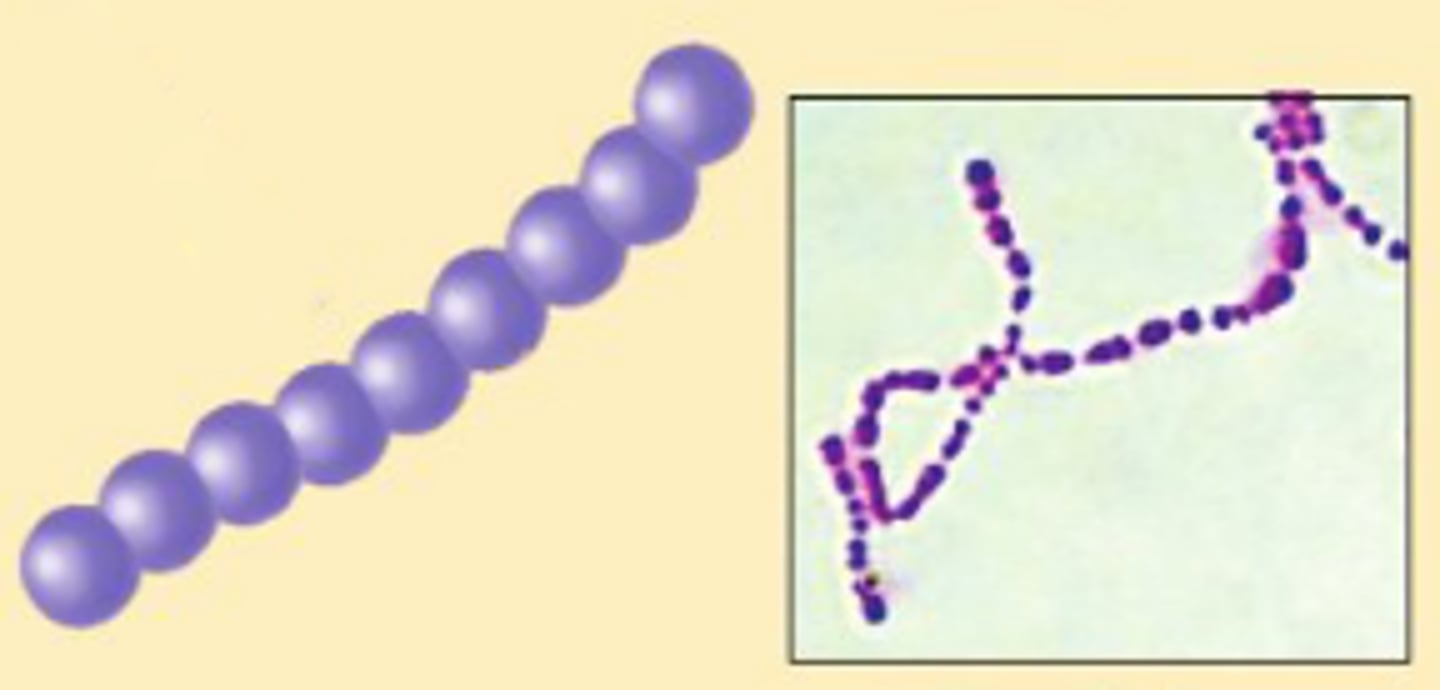
what does the prefix staph- mean?
grape-like clusters
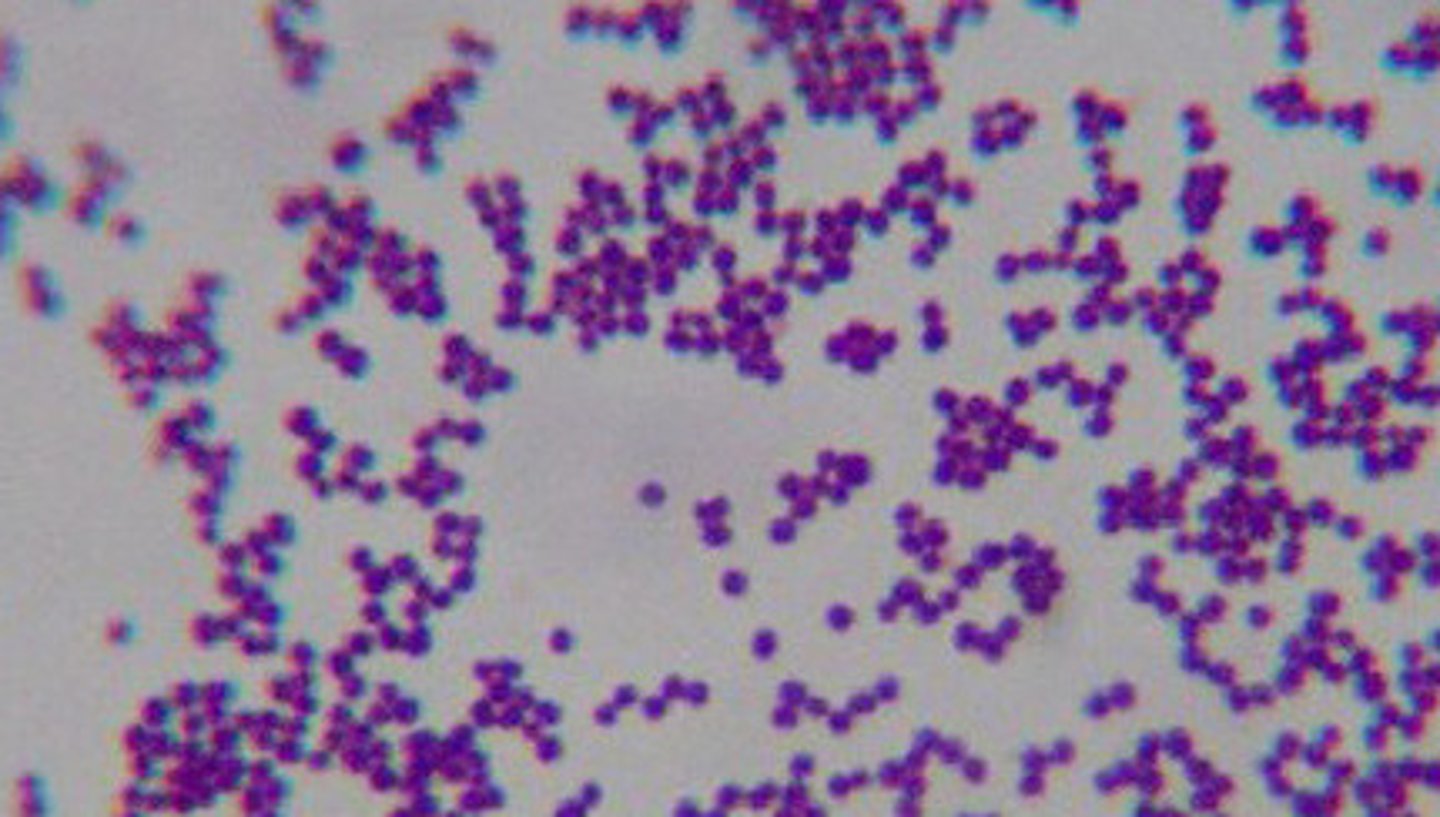
what is a tetrad?
4 cocci in a square
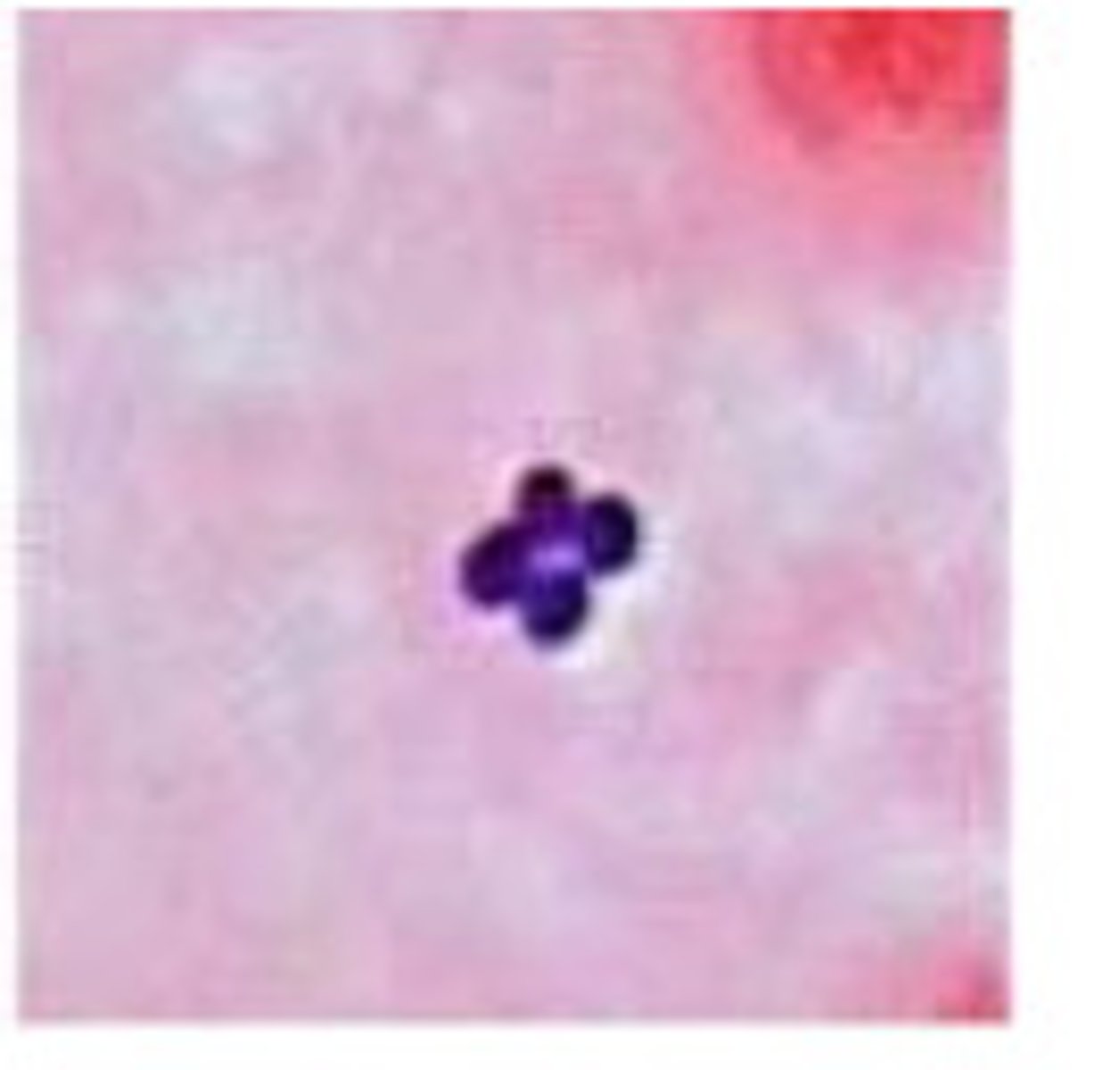
what does sarcinae mean?
cubic configuration of 8 cocci

what are coccobacilli?
very short rods

what are spirochetes?
flexible spiral bacteria
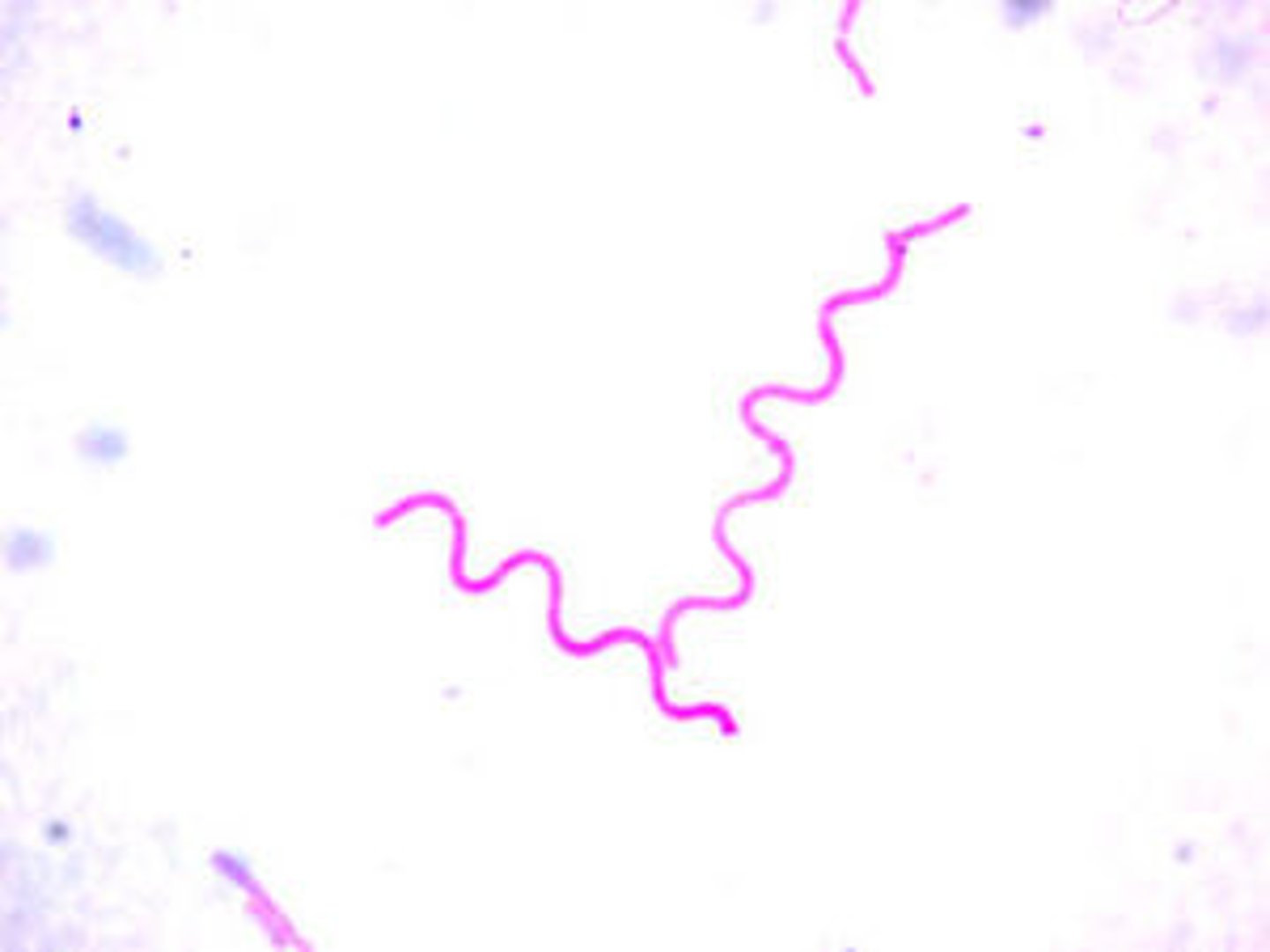
what are mycelium?
network of long, multinucleate filaments

(t/f) bacteria have a membrane-bound nucleus
false; have a nucleoid that is usually not membrane bound
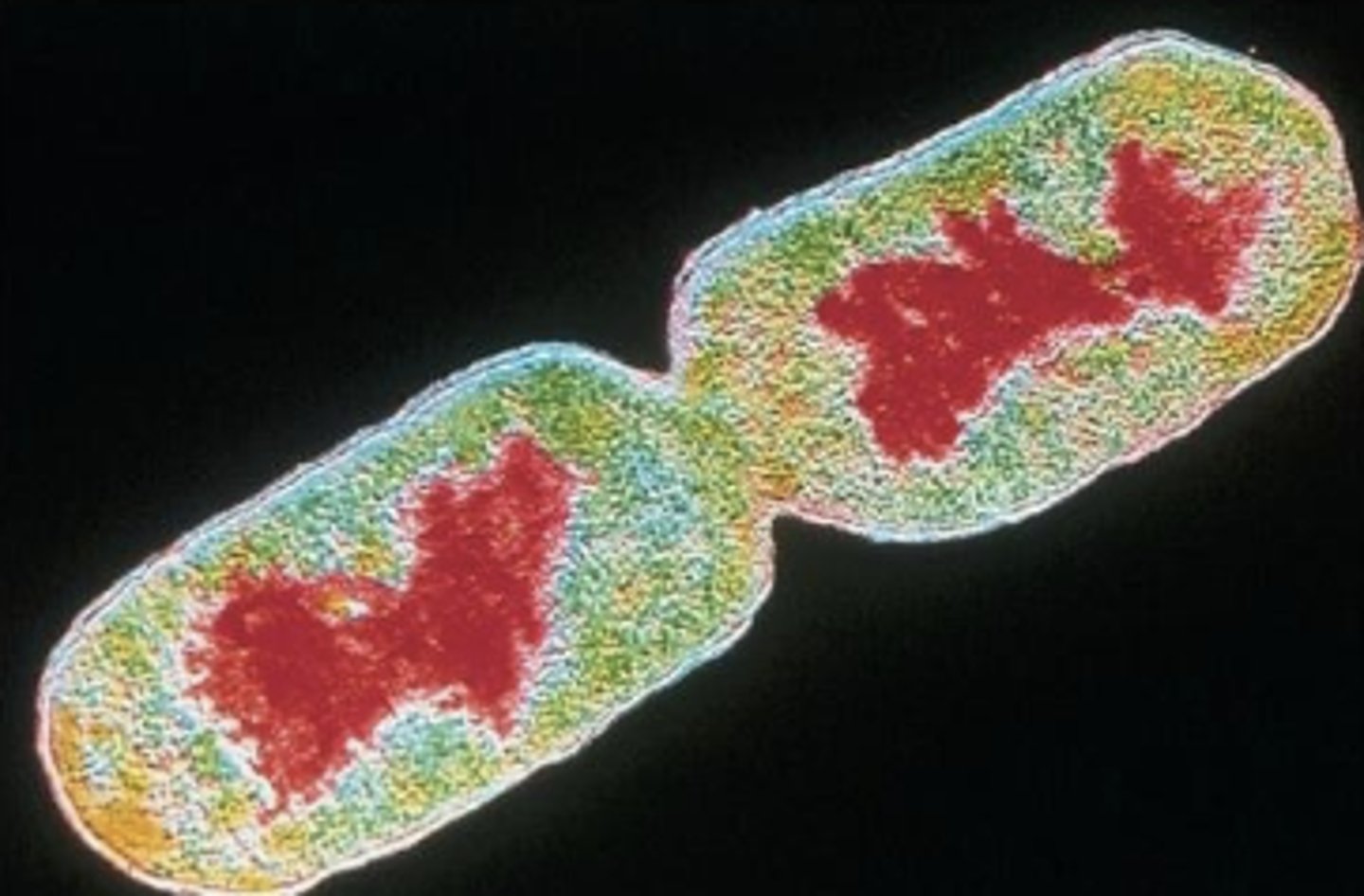
where are the chromosomes and their associated protein located in a bacteria?
nucleoid
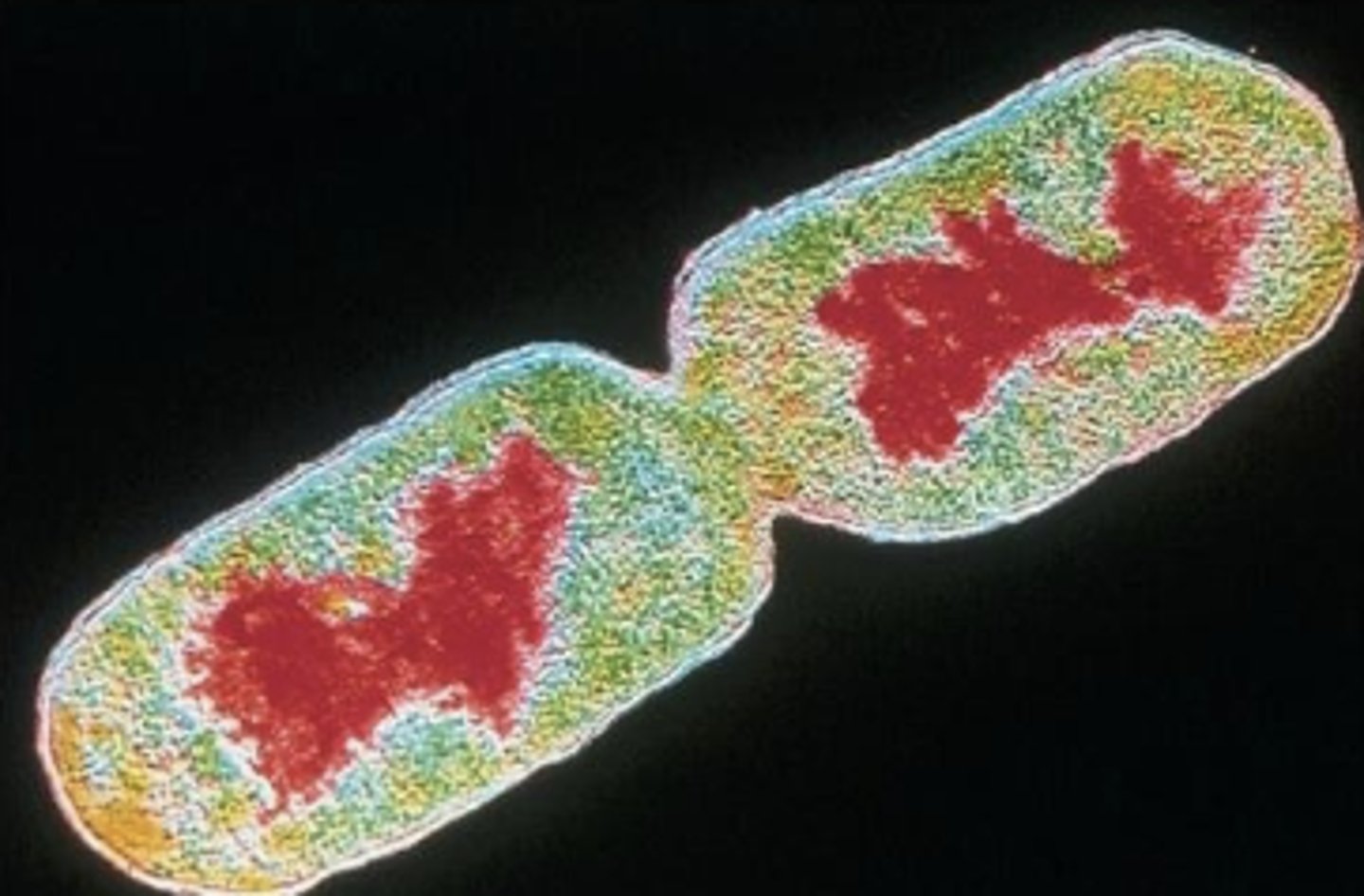
the nucleoid is made of (multiple/one) (opened/closed) (circular/linear) (single/double) stranded (RNA/DNA) molecule
one, closed, circular, double, DNA
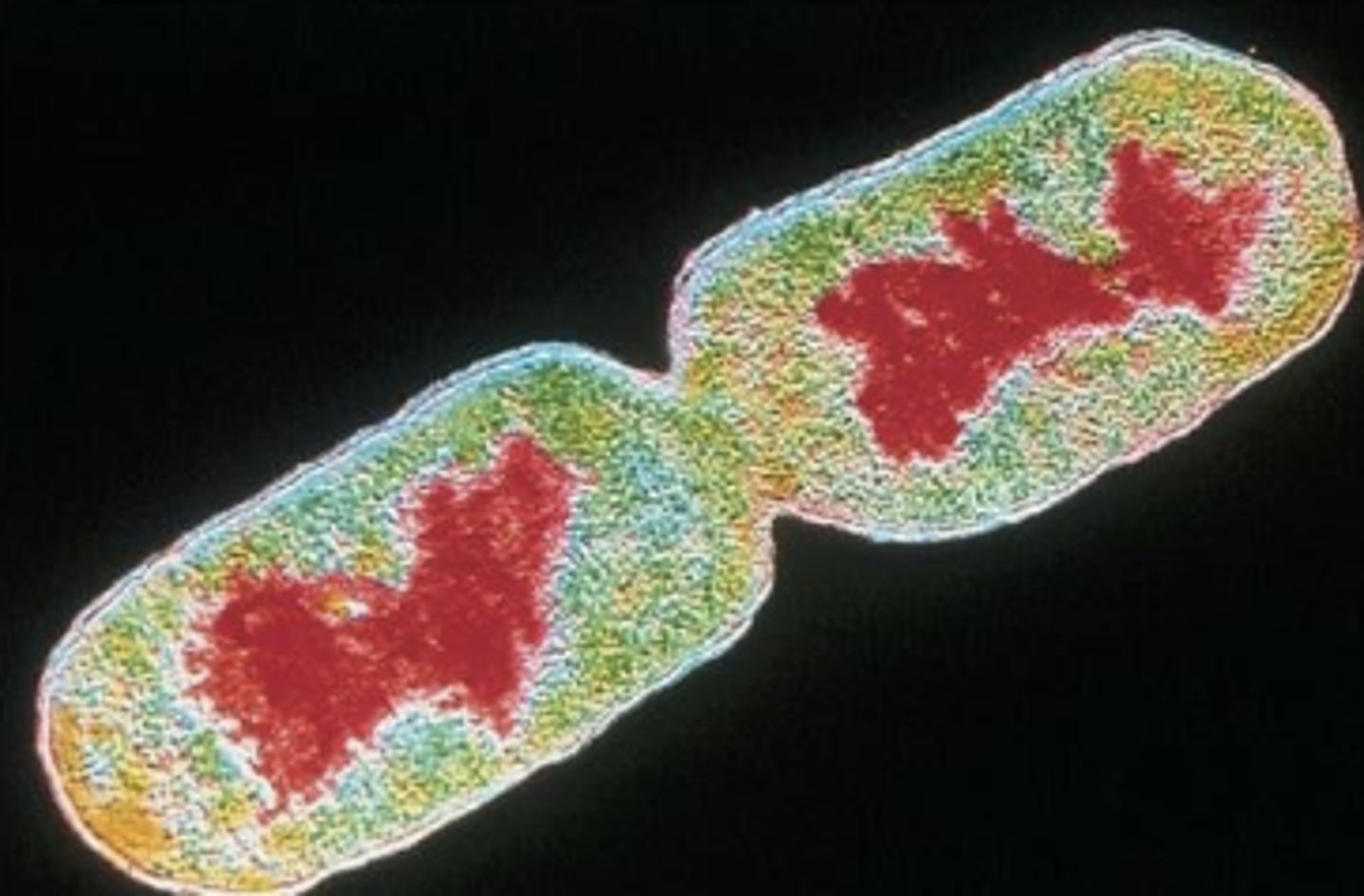
what are the 2 proteins found in the nucleoid that aid in folding (different from histones)?
1. supercoiling proteins
2. nucleoid proteins
what are plasmids?
extrachromosomal DNA; usually small, circular and closed
(t/f) plasmids can be found in bacteria, archaea, fungi, and eukaryotes
false; cannot be found in eukaryotes
(t/f) plasmids divide independently of the chromosome
true
(t/f) plasmids will not be inherited during cell division
false
what is an episome?
when a plasmid incorporates into the circular DNA of a bacterium
(t/f) plasmid genes are non-essential
true; but these genes do offer selective advantage to the host (drug resistance)
what are the plasmids that carry antibiotic resistance genes?
R plasmids
what are the plasmids that carry virulence genes?
virulence plasmids
what do polyhydroxybutyrate granules in bacterial cytoplasm store?
carbon
what do sulfur globules in bacterial cytoplasm store?
sulfur
what are the gas vesicles in the cytoplasm used for?
buoyancy control
what inclusion body in the cytoplasm is the location of carbon fixation reactions?
carboxysomes
what bacterial organelle is associated with direction finding?
magnetosomes
(t/f) similar to eukaryotes, bacterial transcription and translation happens in 2 different parts of the cell
false; in bacteria, transcription and translation occur in the SAME compartment
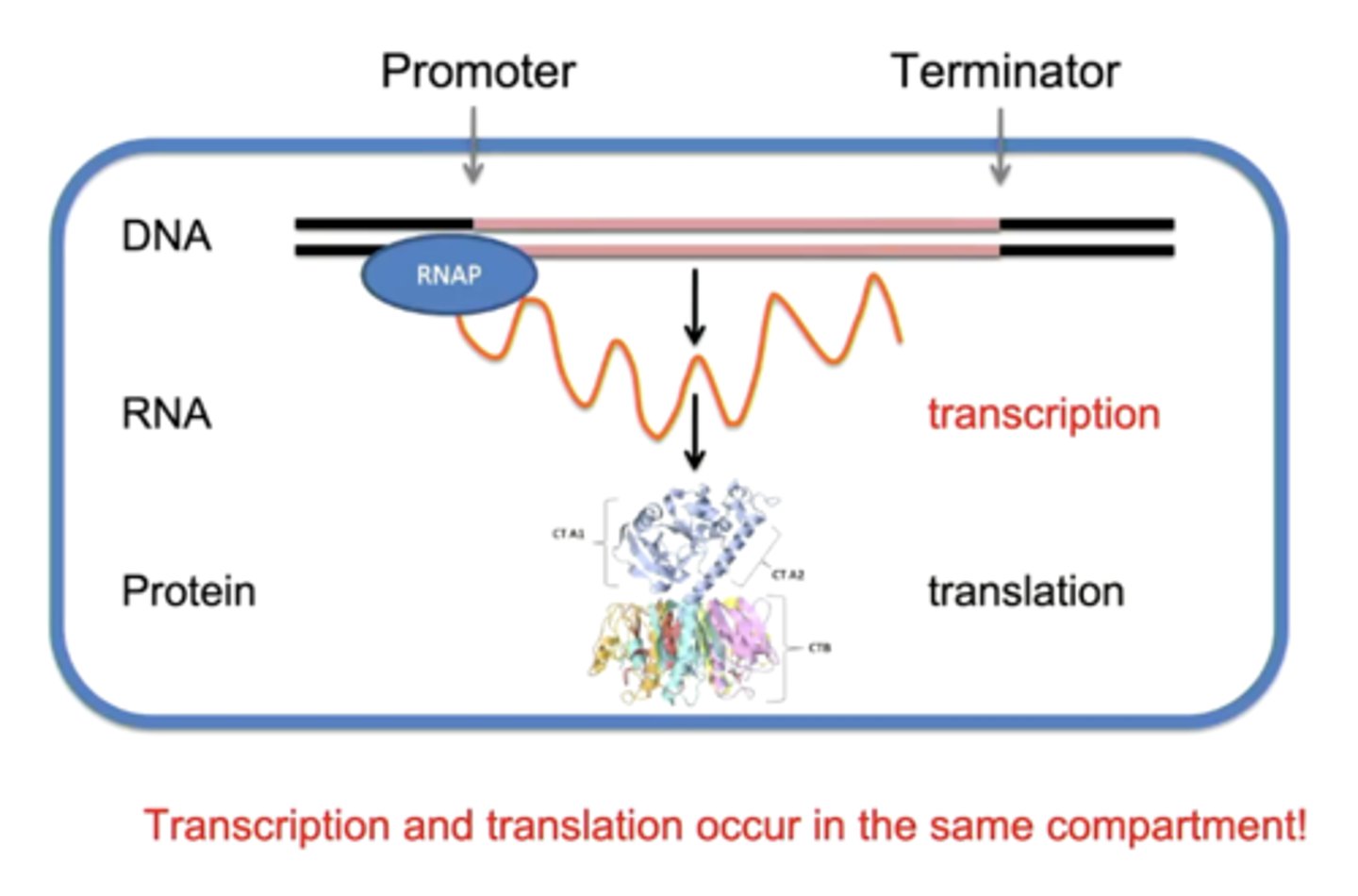
what is the name of the factor that is involved that associates with RNA polymerase to recognize promoters during transcription? when does it disassociate from RNA polymerase?
sigma factor; this factor then disassociates during elongation
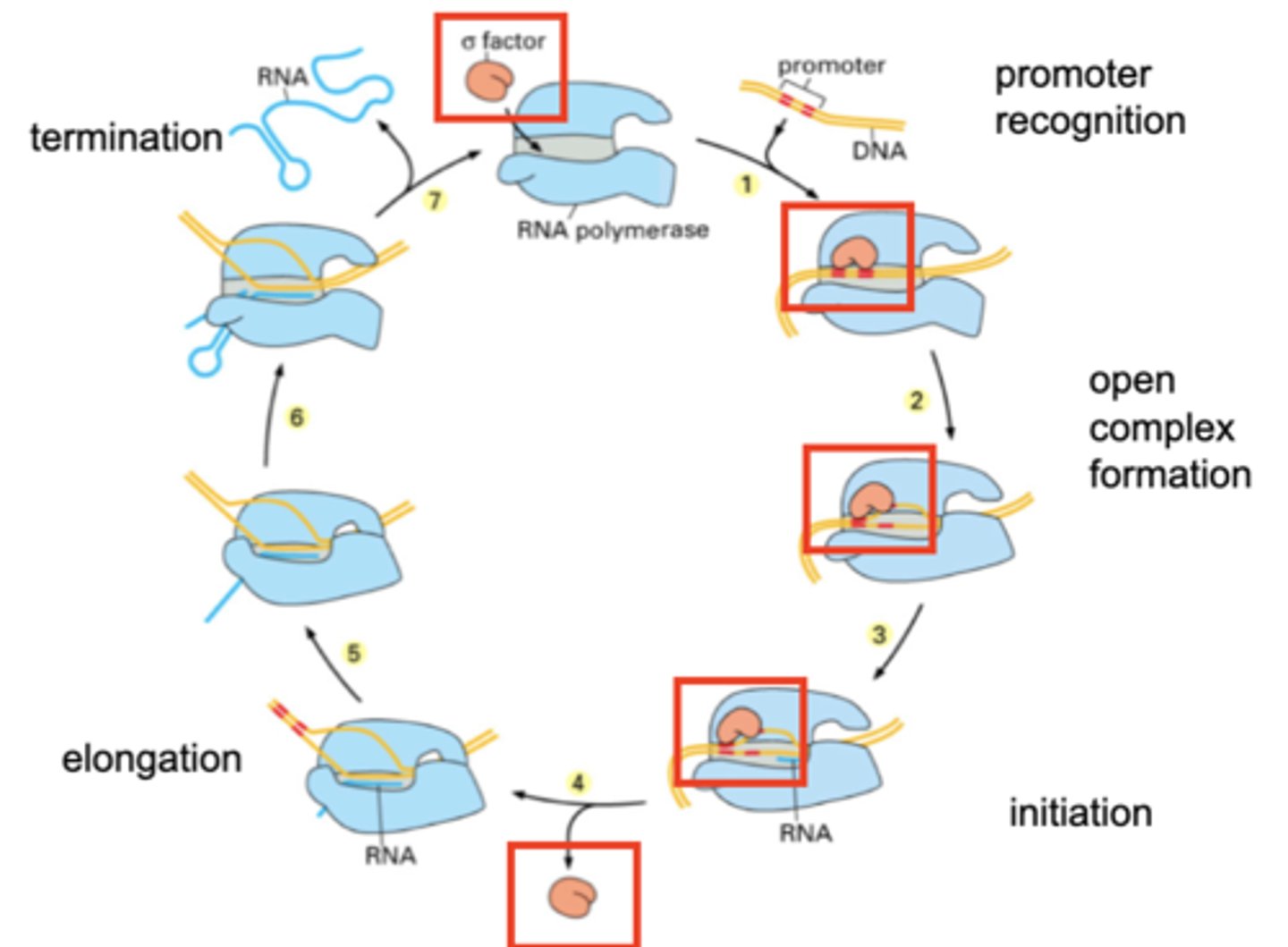
at which step of bacterial transcription is where gene expression is most commonly regulated?
promoter recognition; transcription repressors and activators affect the sigma factors ability to recognize the promoter
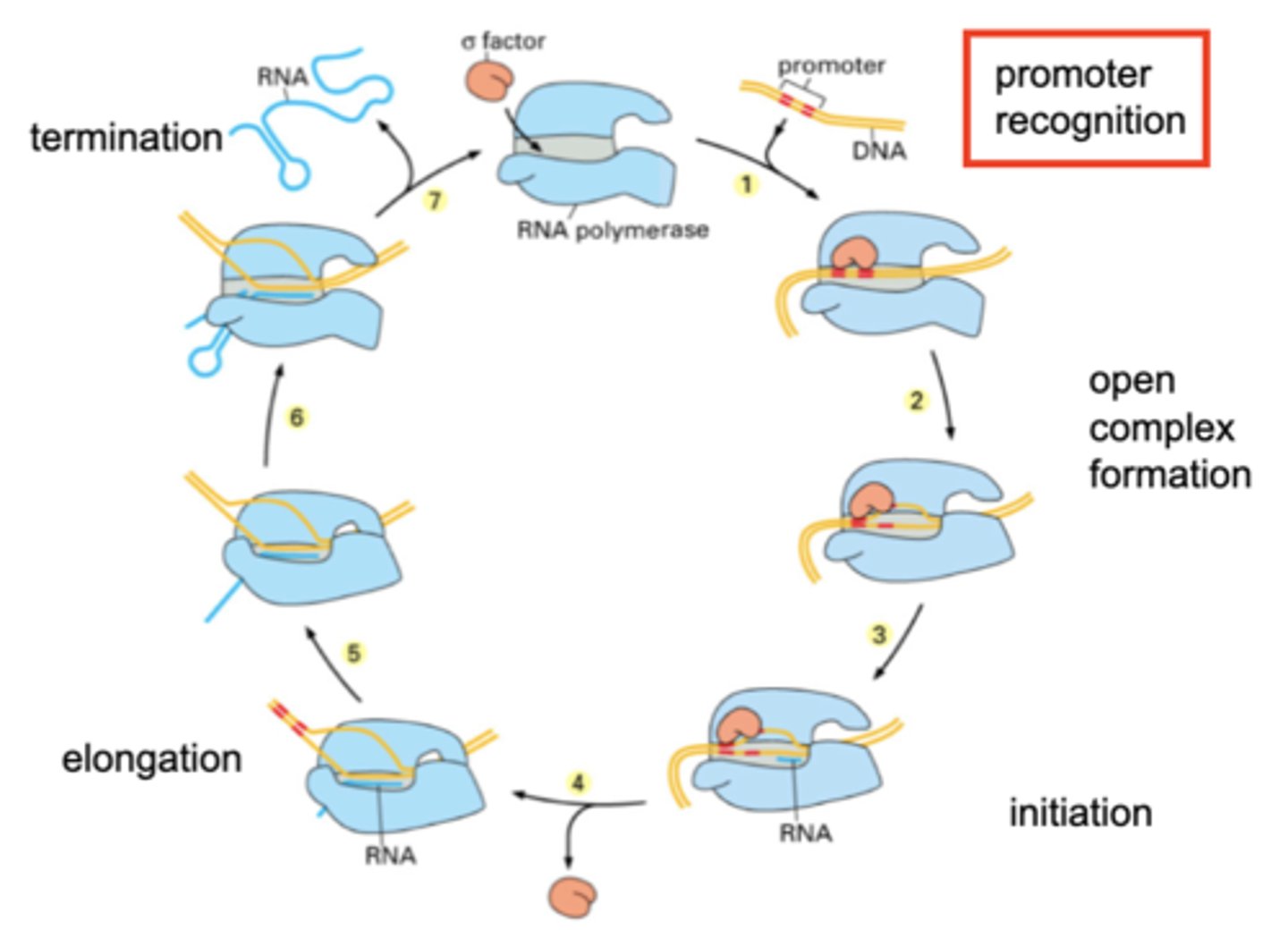
what is the name of the antibiotic that can be used to prevent bacterial transcription initiation?
rifampicin
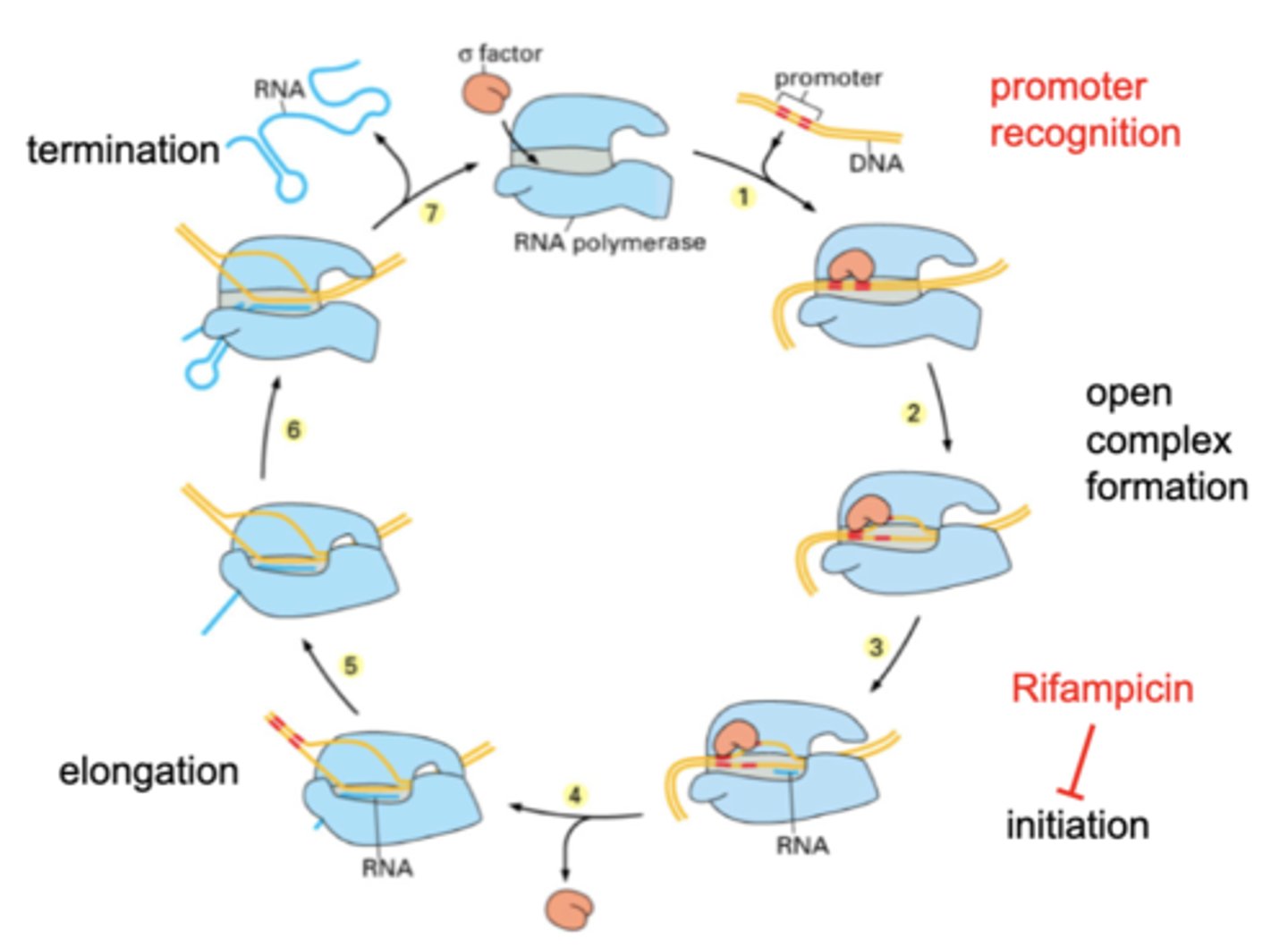
bacteria have operons. what are these?
groups of genes transcribed from one promoter on one long transcript
what are the 2 components of the operon?
1. promoter
2. operator
which component of the operon designates the RNA polymerase binding site and is the point at which RNA synthesis begins?
promoter
which component of the operon is the transcription factors binding site?
operator
what is the name of the operon found in E. coli that allows the bacteria to use lactose when glucose is unavailable?
lac operon
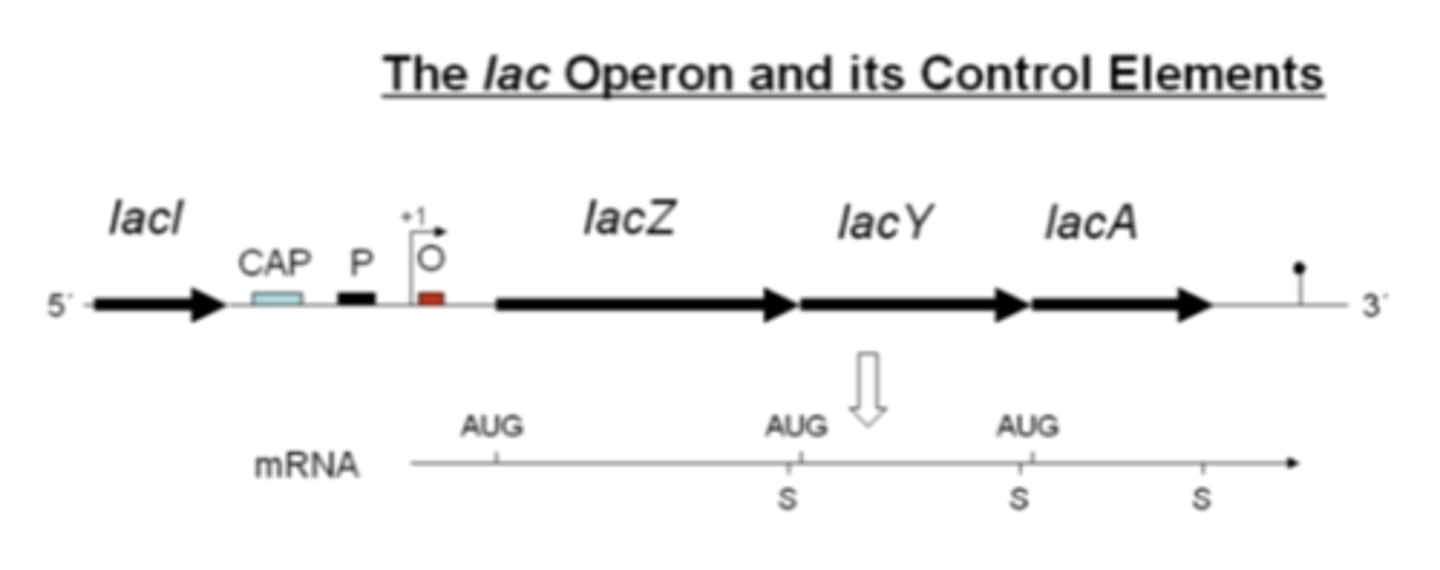
what is co-transcriptional translation?
as RNA is being transcribed from bacterial DNA, RNA is covered with ribosomes that bind to the RNA and start translating the proteins; transcription and translation happen at the SAME time
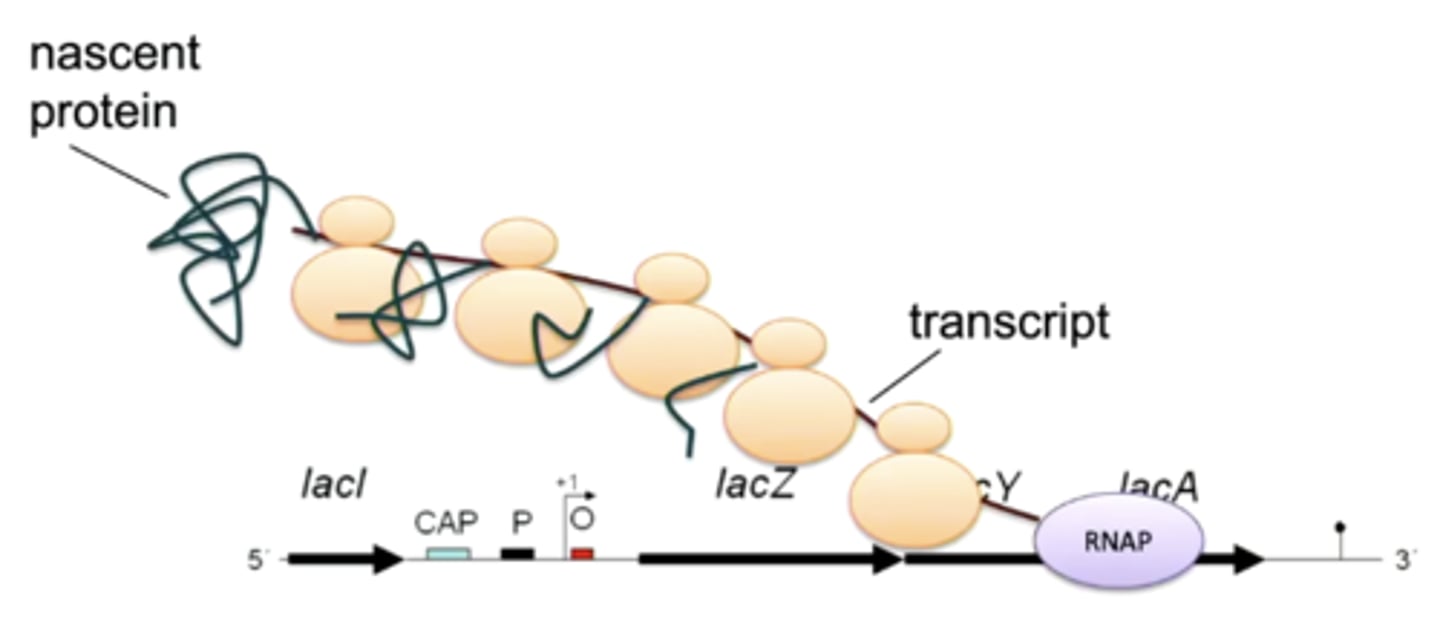
what is internal translation?
bacterial ribosome doesn't have to begin translating an mRNA molecule at the very beginning (5' end) but instead initiates at a point further downstream, within the mRNA sequence
what are the 2 main targets of antibiotics on bacteria?
1. cell wall
2. ribosomes (translation)
(t/f) not all cells will have a plasma membrane
false; all cells have a plasma membrane usually composed of a phospholipid bilayer and embedded proteins to separate the interior of the cell from the external environment
what are the sterol molecules some bacterial plasma membrane may have? what do they do?
hopanoids; helps with stability across temperature changes

how does O₂ and CO₂ cross the plasma membrane of the bacteria?
small enough to diffuse across the plasma membrane readily
how does H₂O cross the plasma membrane of the bacteria?
with aquaporin protein channels
how do sugars cross the plasma membrane of the bacteria?
with ATP-binding cassette (ABC) transporters
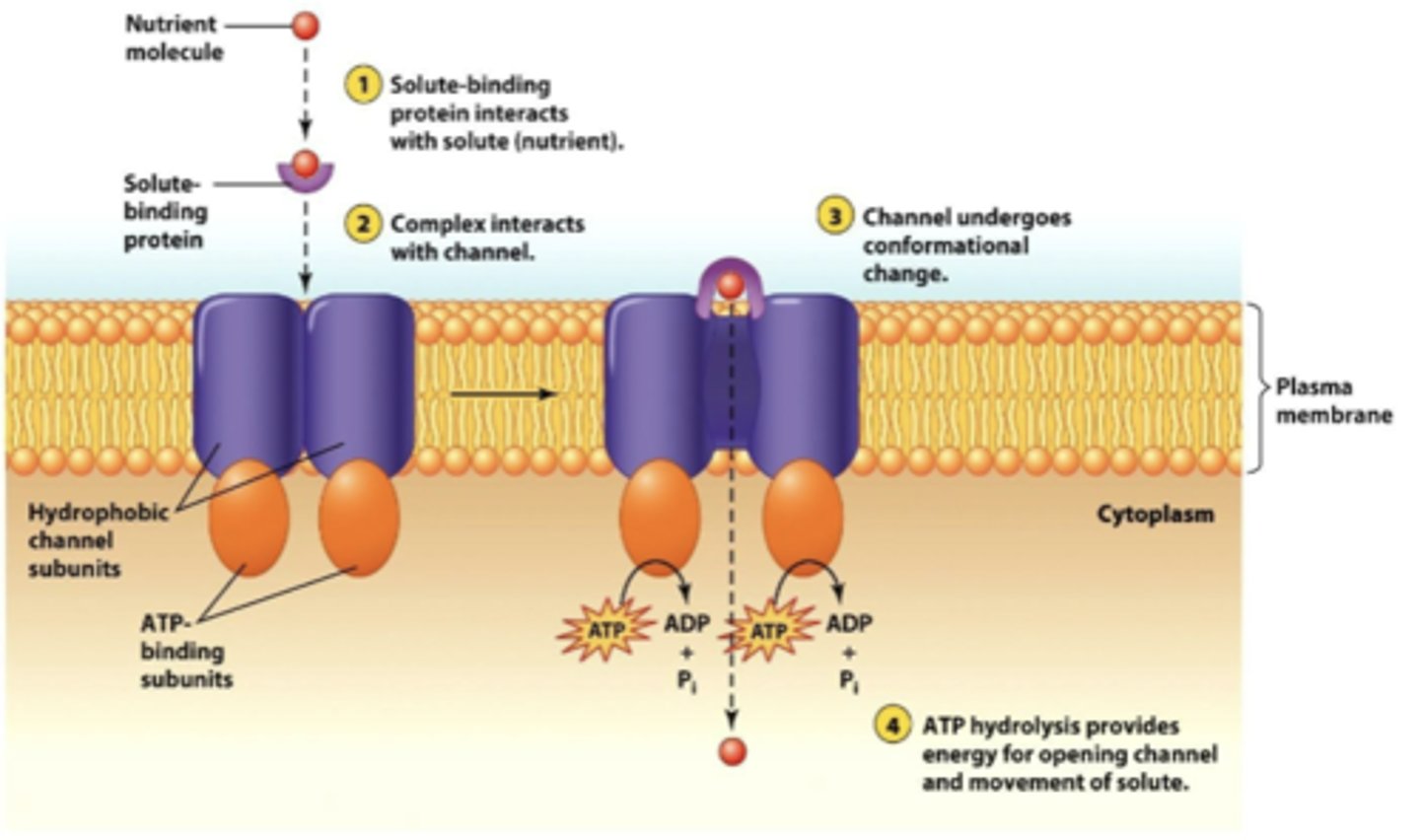
what is osmosis?
the flow of water across the plasma membrane toward the side with a higher solute (particle) concentration
what structure can help keep a bacterial cell during periods of extreme moisture (swelling) or extreme dryness (shriveling)?
a cell wall
what are 2 ways nutrients can cross the plasma membrane?
1. facilitated diffusion
2. active transport
what is facilitated diffusion?
using a protein channel to move particles with a concentration gradient; does NOT require energy
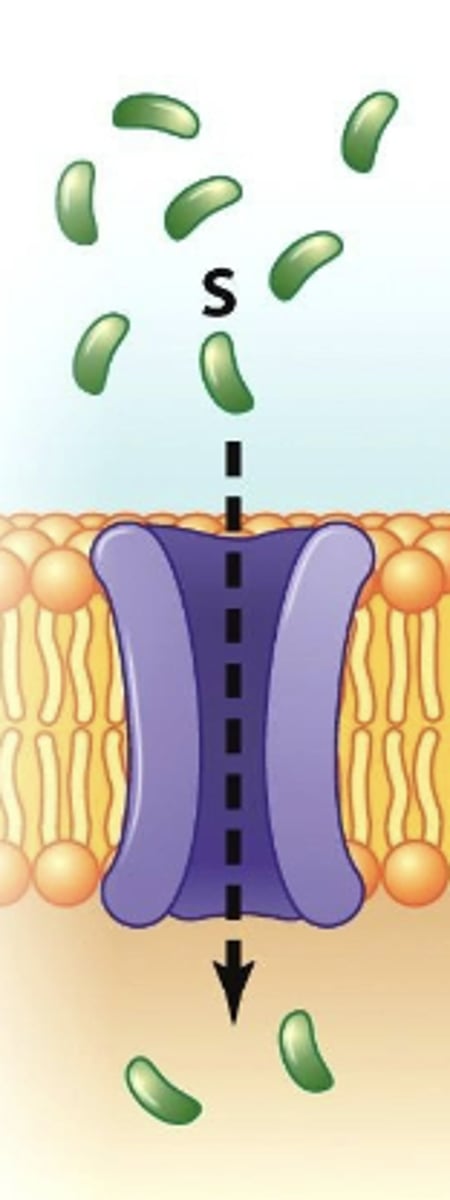
what is active transport?
using energy to move particles AGAINST a concentration gradient; e.g. symport/antiporters, ATP-binding cassette (ABC) transporters
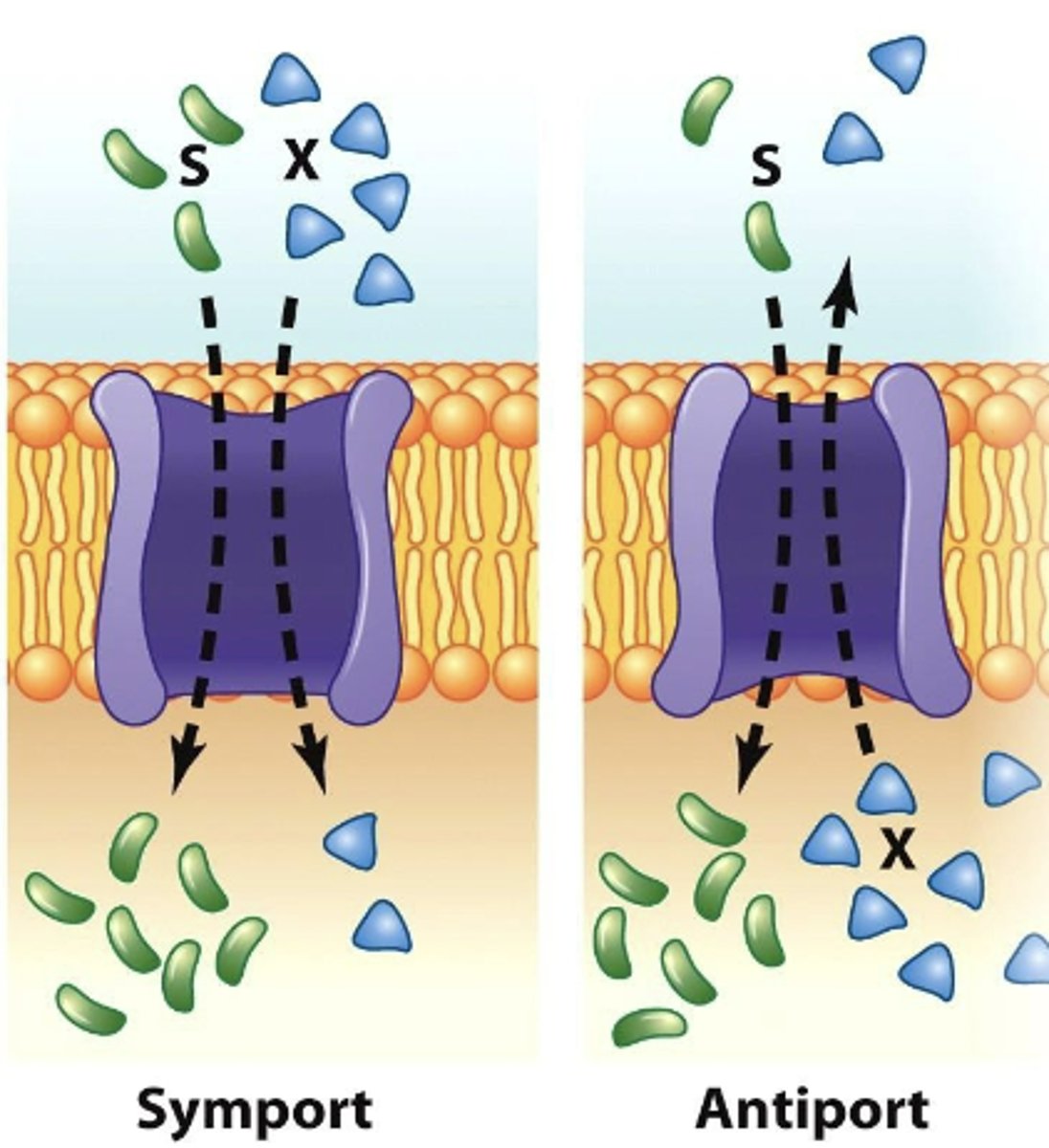
what are 3 ways the bacterial plasma membrane can used captured energy?
1. ETC to create proton motive force (PMF)
2. respiration/photosynthesis
3. energy for motion (flagella)
proteins in the plasma membrane can be used to detect environmental changes. how does the bacteria respond?
detected changes can cause the bacteria to alter gene expression

(t/f) protein secretion from the bacteria only requires proton motive force
false; protein secretion from the bacteria requires proton motive force and ATP
gram negative vs positive: contains an inner and outer membrane
negative
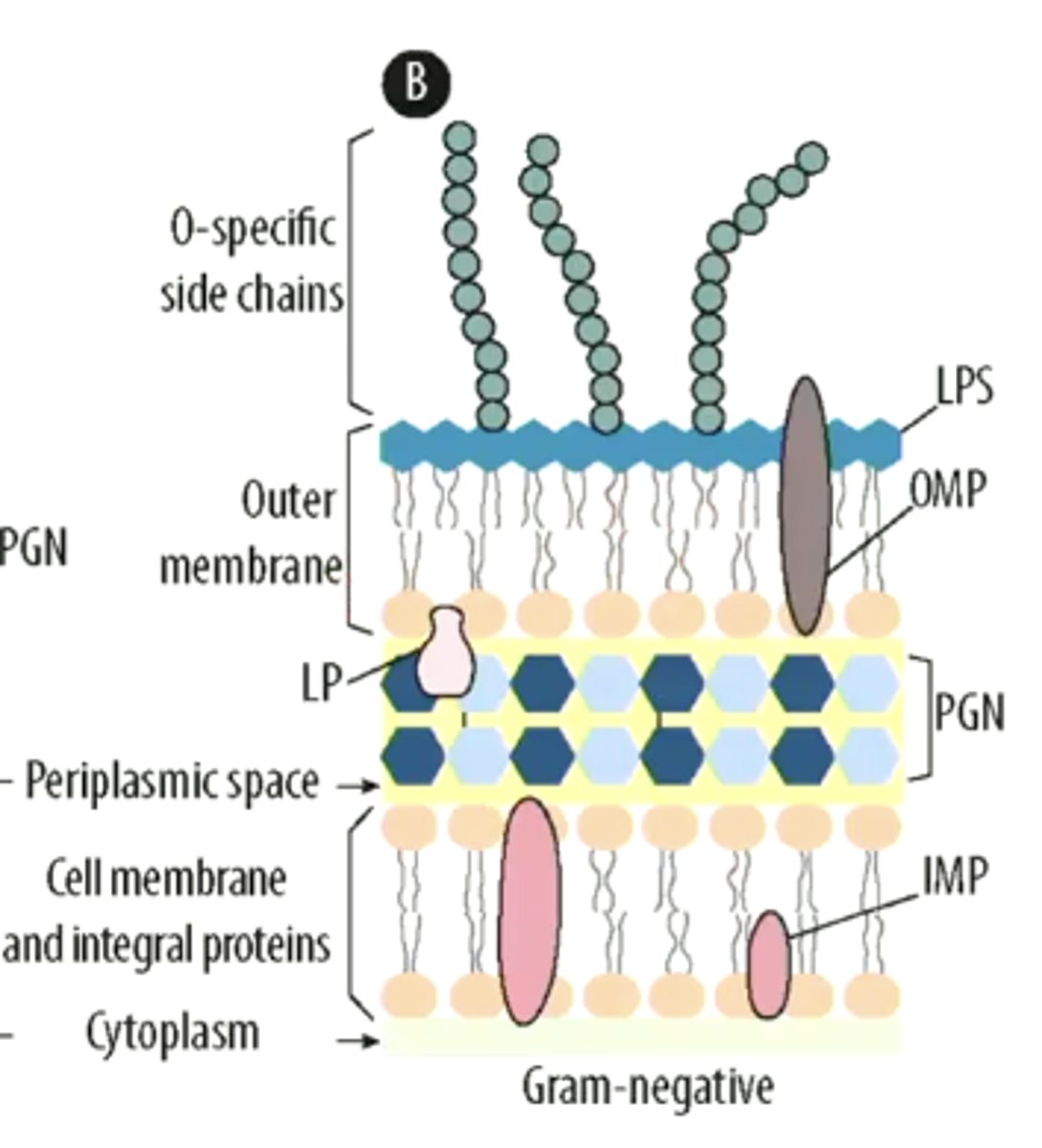
what are sortases?
enzymes that anchor surface proteins to the cell wall, helping in adhesion, invasion, and immune evasion
gram negative vs positive: contains sortases
positive